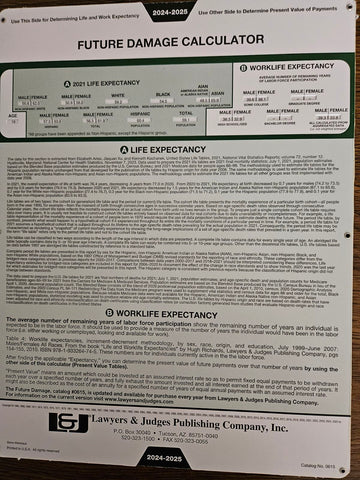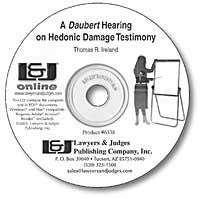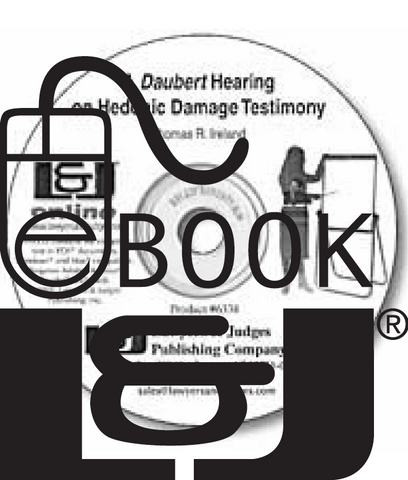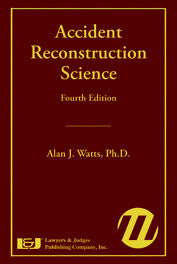
Medical Errors and Litigation PDF eBook
-
Author: Jon R. Abele
-
ISBN 10: 0-913875-80-5
-
ISBN 13: 978-0-913875-80-3
-
Copyright Date Ed: June 16, 2004
-
Pages: 375 pages
- PDF eBook
Medical errors are an unfortunate part of our healthcare system. Not only are patients exposed to understaffed hospitals and overworked doctors, nurses and technicians, but they also face medical device failures and untrained staff. All these factors contribute to patient injuries. It is important for attorneys, healthcare professionals, and insurance agents to know how an error was made and who is responsible.
Medical Errors and Litigation Investigation and Case Preparation will take you through the process of handling your medical error case. Once you've determined that a patient has a legitimate complaint, this book will help by providing you a guideline for sorting through the overwhelming amount of paper work and bureaucracy involved in a medical errors case.
The authors of this book have backgrounds in both the medical and legal profession. Their expertise will help you know how to identify responsible parties, understand the roots of patient injuries, sort through the standards of care and gather information from medical records. Once you've begun building your case, the book will provide you with ideas for finding medical experts, presenting your case to a jury and alternatives to litigation and trials. This book has something for everyone involved in a medical errors case.
Topics include:
- Roots of patient injury
- Patient care algorithms
- Medical instruments and devices
- Client intake
- Analyzing medical records
- Identifying responsible parties
- Standard of care experts
Table of Contents
1. Roots of Patient Injury
1.1 Introduction
1.2 Incompetence
A. Competence on a continuum
B. Fatigue
C. The National Practitioner Data Bank
D. Healthcare Integrity and Protection Data Bank
1.3 Lack of Knowledge and Experience
A. Board certification
B. Nurse certification
1.4 Impaired Critical Thinking
A. Physicians∂ cognitive errors
B. Errors and critical thinking
C. Types of errors
1.5 Chemical Dependency
A. Substance abuse and physicians
B. Substance abuse and nurses
C. Profile of the Nurse Practice Act violator
1.6 Distractions and Interruptions
1.7 Communication Breakdowns
1.8 Increased Complexity of Medical Care
A. Failure to follow agency policy
B. Improper use of equipment
1.9 Inadequate Staffing
A. Need for nurses
B. Shortage of nurses
1.10 Improper Delegation by Physicians
A. Nurse practitioners
B. Nurse-midwives
C. Physician assistants
1.11 Improper Delegation by Nurses
A. Licensed practical nurses
B. Unlicensed assistive personnel
1.12 Poor Customer Relations and Patient Injury
A. Predisposing factors
B. Precipitating factors
1.13 Concealment of Errors
A. Failure to intervene
B. Concealment of errors
C. Mandatory reporting of errors
1.14 Summary
2. Codes of Medical Ethics and a Clinician∂s Duties to the Patient
2.1 Introduction
2.2 Autonomy of the Person
A. Informed consent
B. Exceptions to informed consent
C. Incompetence and surrogate decisionmakers
D. Advance directives
E. Paternalism redux
2.3 Nonmalfeasance (Primum Non Nocere)
A. Technical competence and the standard of care
B. Medical futility
C. Quality of life and the withdrawal of treatment
D. Patient abandonment
2.4 Beneficence
A. Research protocol and experimental treatments
B. Pain management
C. Physician-assisted suicide and euthanasia
2.5 Distributive Justice
A. Allocation of medical resources
B. Issues specific to organ transplants and donations
C. Treatment of underserved populations
2.6 Truthfulness
A. Privacy and confidentiality
B. Conflicts of interest between the patient and third parties
C. Conflicts concerning the physician∂s self-interest
D. The placebo effect
E. Elective and controversial procedures
2.7 Conclusion
3. Medical Instruments and Devices
3.1 Introduction
3.2 Overview
3.3 Case Study: The Unstoppable X-ray Machine
3.4 Product Defects
A. Manufacturing defects
B. Design defects
C. Defects in labeling
D. Defects induced by the user
3.5 Malpractice Claims in Medical Device Cases
3.6 Medical Device Regulations
A. Medical Device Amendments of 1976
B. The Safe Medical Devices Act of 1990
C. Safe Medical Device Amendment of 1992
D. Biomaterials Access Assurance Act of 1997
E. FDA Modernization Act of 1997
F. Restatement (Third) of Torts: Products Liability
3.7 Some Common Defenses
A. Learned intermediary doctrine
B. Preemption
3.8 Investigation Checklist
3.9 The Process
A. The complaint
B. Discovery
C. Requests for jury voir dire
3.10 Conclusion
4. Making Sense of Standards of Care
4.1 Introduction
4.2 Elements of Malpractice and Their Relation to Standards of Care
A. Duty
B. Breach of duty
C. Causation
D. Injury
4.3 The Learning Curve
4.4 The Process
A. Recognition
B. Analysis
C. Research
D. Application
4.5 Sources of Standards of Care
A. Statutes and laws: Federal and state; case law
B. Regulations and agencies: Federal and state
C. Organizations‹Private and professional
D. Academic curricula
E. Authoritative textbooks
F. Professional journals
G. Manufacturer∂s instructions
H. Institutional policies and procedures manuals, bylaws, and job descriptions
I. Expert witnesses
J. Treating physicians and other treating healthcare providers
4.6 Research Tools
4.7 Standard of Care: Application and Examples
A. Clear-cut, single-source standards
B. Off label drug use: A deviation from the standard of care?
C. Medical folklore
D. Specific treatment issues
4.8 Conclusion
5. Gathering Information: Medical and Other Records
5.1 The Content of Medical Records
5.2 The Retention of Medical Records
5.3 The Confidentiality of Medical Records
5.4 Which Records to Obtain
A. Medical malpractice cases
B. Personal injury cases
C. Birth injury cases
D. Wrongful death cases
5.5 Obtaining Medical Records and Information
5.6 Locating Physicians, Hospitals and Healthcare Facility Addresses
5.7 Ensuring That the Record Is Complete
5.8 Subpoenaing Medical Records and Information
5.9 Conclusion
6. Analyzing Medical Records
6.1 Introduction
6.2 Obtaining Medical Records
6.3 Special Requests
6.4 Components of Medical Records
A. Special records
B. Indexing
6.5 Analysis of Medical Records
A. Initial approach
B. Comprehensive review
C. Review of hospital records <brD. Review of outpatient records
6.6 Review of the Long-Term Care Record
A. Introduction
B. Components of the long-term care record
6.7 Review of Personal Injury Records
A. Rescue squad records
B. Emergency room records
C. Physician∂s office records
D. Analysis of physician factors affecting personal injury cases
E. Analysis of physical therapy factors affecting personal injury cases
F. Analysis of chiropractic care factors affecting personal injury cases
G. Analysis of attorney factors affecting personal injury cases
6.8 Altered Medical Records
A. Late entries
B. Missing records
C. Falsified entries
D. Late dictation
E. Discrepancies between nurses∂ and physicians∂ entries
F. Inaccurate medical billing
G. Pathology reports that do not correlate to procedures performed
H. Disparity between patient∂s account of events and entries in the medical records
6.9 Checklist
6.10 Summary
Appendix A. Glasgow Coma Scale
Appendix B. Medical Abbreviations
7. Finding Medical Experts and Consultants: The Internet Way
7.1 Qualities of an Expert
7.2 Background of Focused and Generic Expert Searches
A. Focused search
B. Generic search
7.3 Detail of Search Methods
A. PubMed review
B. Footnote review method
C. Selecting the expert with the AMA-PS opened to ∏specialty∑
D. Use of jury verdict reports
E. Medical school faculty search
F. KnowX® search
7.4 Final Steps before Making the Call
A. Check the medical and narcotic licenses and publications
B. Finding telephone numbers
C. Contacting the expert <brD. Using the expert evaluation form
E. Sending the file
Appendix
8. Voir Dire and Medical Malpractice
8.1 Introduction
8.2 Alternate Methods of Selecting the Panel of Potential Jurors to Question from the Pool
8.3 Voir Dire: The Parameters
8.4 Objections During Voir Dire
8.5 Questioning the Panel
8.6 Challenges for Cause
8.7 Preserve the Record
8.8 Bias or Prejudice of the Juror
8.9 Eliciting Information from the Panel
8.10 Peremptory Challenges
8.11 Limitations on Peremptory Strikes
8.12 Pretext for Discrimination
8.13 Voir Dire in the Era of Medical Liability Reform




